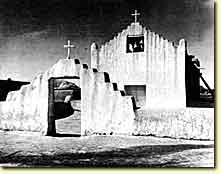By the time the Gold Rush began, hundreds of people like Vicente Peralta had
already established successful businesses in California. Peralta owned Rancho
San Antonio, some 19,000 acres of land on the coast of northern California. He
prospered in the cattle trade.
 Vicente Peralta and his family were part of a group of people known as
Californios--Spanish-speaking people who had come from Mexico or Spain
to settle in California. Californios had lived on California soil since 1769.
That's when Spanish priests began building missions, or Catholic churches,
along the coast, in hopes of converting Native Americans to Christianity. Vicente Peralta and his family were part of a group of people known as
Californios--Spanish-speaking people who had come from Mexico or Spain
to settle in California. Californios had lived on California soil since 1769.
That's when Spanish priests began building missions, or Catholic churches,
along the coast, in hopes of converting Native Americans to Christianity.
The mission settlements included large land areas, on which mission settlers
and Native American laborers grew crops such as wheat and corn and raised
livestock. Settlers also lived outside the mission, in small towns called
pueblos. In forts known as presidios, Spanish soldiers helped guarantee Spain's
hold on the land.
For decades, the Spanish priests were the most powerful group in California.
But when Mexico won independence from Spain in 1821, Californios began to break
free of this religious control. In 1834, the Mexican government took possession
of the land owned by the missions. After applying to the government,
Californios received grants for large areas of land--from 10,000 to over
100,000 acres.
Soon the Californios established sprawling ranchos, or cattle ranches,
along the coast. Most of the ranchers sold cattle hides and tallow, animal fat
used to make candles and soap. Some made wine and grew citrus fruits, which
were exported. By 1850, some 200 Californio families like the Peraltas owned
about 14 million acres of land.
Life for the Californios changed after the Mexican War (1846-1848), fought
between the United States and Mexico. At the war's end, California belonged to
the United States. The Treaty of Guadalupe Hidalgo made Californios U.S.
citizens and guaranteed them the rights to their lands. But these rights would
soon be weakened.
The same year the war ended, the first cry of "Gold!" rang out. By 1852, about
250,000 miners from around the world had arrived in California. Now the
Californios were a minority. It didn't matter that they had lived on their
lands for generations. In the eyes many the new commers, the Californios were "foreigners."
As competition for gold increased, resentment toward Californios and miners
from Mexico, Chile, and other Latin American countries grew. In 1850, the
Foreign Miners Tax Law was introduced. It meant that "foreign" miners,
including Californios, had to pay $20 a month if they wanted to mine.
Some of the forty-niners who failed at mining wanted
something to show for their trouble. So they took land--some of which belonged to the Californios. Some miners
squatted, or lived on the ranchos without the permission of the
landowners. Many squatters seized land violently, killing cattle, burning
crops, and chasing Californios out of their homes. Others used the courts to
make unfair claims on the Californios' property.
That's how the Peralta family lost Rancho San Antonio. After gaining Vicente
Peralta's trust, a lawyer named Horace Carpentier encouraged Peralta to sign a
document that would protect his land. But Carpentier had lied. The document
actually required Peralta to pay rent on his land--or lose it. Peralta refused
to pay the rent, and the government seized his land. Carpentier then bought
the land for himself.
 The Land Law of 1851 made matters worse for the Californios. It set up a group
of people to review the Californios' land rights. When a new settler claimed
the rights to a Californio's land, the two parties would battle it out in
court. The Land Law of 1851 made matters worse for the Californios. It set up a group
of people to review the Californios' land rights. When a new settler claimed
the rights to a Californio's land, the two parties would battle it out in
court.
Some Californios fought for their land all the way to the Supreme Court. But
often, after years of spending money on legal fees, they were forced to give
up. With no money left to defend themselves, they sold their lands or
surrendered their property rights.
A few Californios managed to hang on to their property. Juana Briones, a widow
who lived in what is today Palo Alto, kept control of her 4,400 acre rancho.
But by the 1870's, the Californios' empire was gone.
 Still, the Californio legacy lives on in California today. The citrus and wine
trades are now among California's largest industries. The names of many
California cities--San Francisco, San Jose, Monterey, Los Angeles, and San
Diego--reflect the Spanish-speaking people who first settled them. And
Californio influence can be seen in all aspects of California culture, from its
architecture and music to its food and art. Still, the Californio legacy lives on in California today. The citrus and wine
trades are now among California's largest industries. The names of many
California cities--San Francisco, San Jose, Monterey, Los Angeles, and San
Diego--reflect the Spanish-speaking people who first settled them. And
Californio influence can be seen in all aspects of California culture, from its
architecture and music to its food and art.
|
|

